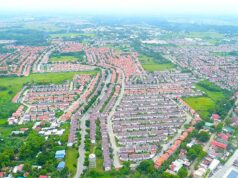ANGELES CITY – The president of the Philippine Pyrotechnics Manufacturers and Dealers Association of the Philippines, Inc. (PPMAP) said yesterday Health Sec. Armando Duque’s proposal to ban the use of pyrotechnic products in residential areas is bound to fail, as he warned that the move to totally ban firecrackers would violate the law.
“Nagpapa-pogi lang siya (He is just grandstanding). If he wants to really ban fireworks, then he should not be just saying it. He should seek legislation scrapping an existing law,” PPMAP president Celso Cruz said yesterday in a telephone interview.
Duque was reported to have batted for the banning of fireworks in residential areas while other reports quoted him as saying that government health authorities would be working with local government units (LGU), particularly city health offices, for the implementation of a total firecracker ban as a measure to reduce injuries.
“He will be violating the law if he enforces total ban,” Cruz said, referring to Republic Act 7183, an act regulating the sale, distribution and use of firecrackers and pyrotechnics devices. It was passed in 1992.
Cruz noted that even former Pres. Marcos failed to ban firecrackers during martial law. He recalled that in 1972 when Marcos imposed martial law, all pyrotechnic products were banned amid fears that the fireworks technology could be used for rebellious plots against the government.
“But Marcos failed. Filipinos still used pyrotechnic products during New Year festivities. So how can Duque dare?” Cruz asked. He noted that Republic Act 7183, also known as the Firecrackers Law, was passed after the government saw the persistence of Filipinos in using fireworks for festivities and celebrations.
Cruz also noted that the use of fireworks during the New Year is “a culture finding root in us for 300 years.”
“For centuries, Filipinos gather in their homes, not elsewhere, to commemorate New Year and that’s where they are used to lighting fireworks,” he said.
Cruz urged Duque to instead shift his attention to illegal manufacturers of fireworks products and other violators of the Firecrackers Law.
He cited the case of those involved in the ongoing World Pyro Olympics in Taguig City which is now on its fourth year.
“We used to tolerate the Olympics in the past three years because then, the events were sponsored by the Department of Tourism (DOT) and we thought it was also a way of promoting our products. But now, it has become purely commercial and is held on a pay-per-view basis,” he noted.
Cruz stressed that the organizers have allowed the importation of finished fireworks products for use during the Olympics.
“The importation of finished fireworks products is prohibited by the firecrackers law. The government now seems to have a double standard on this by allowing the influential importers to violate the law,” he said.
Duque said that firecrackers, whether sold legally or illegally, caused serious injuries to more than 700 people last year. Based on DOH data, the firecrackers that caused the most injuries in 2008 were piccolo, kwitis, 5-star, luces and home-made firecrackers.
In Bulacan where the country’s biggest fireworks manufacturers are located, the provincial government has a pyrotechnic board to address the needs of the pyrotechnics industry.
Jerry Cagingin of Bulacan provincial cooperative and economic development office, said in an interview that the local fireworks industry is worth billions of pesos and provides direct and indirect employment to some 100,000 provincial folk.
Way back in 1999, the provincial government had commissioned experts from Canada and the United States to introduce safe fireworks technology to local manufacturers and has since then been conducting trainings and seminars on proper handling and storage of chemicals through the Department of Science and Technology’s Industrial Technology Development Institute and the Department of Labor and Employment’s Occupational Safety and Health Center.
“Nagpapa-pogi lang siya (He is just grandstanding). If he wants to really ban fireworks, then he should not be just saying it. He should seek legislation scrapping an existing law,” PPMAP president Celso Cruz said yesterday in a telephone interview.
Duque was reported to have batted for the banning of fireworks in residential areas while other reports quoted him as saying that government health authorities would be working with local government units (LGU), particularly city health offices, for the implementation of a total firecracker ban as a measure to reduce injuries.
“He will be violating the law if he enforces total ban,” Cruz said, referring to Republic Act 7183, an act regulating the sale, distribution and use of firecrackers and pyrotechnics devices. It was passed in 1992.
Cruz noted that even former Pres. Marcos failed to ban firecrackers during martial law. He recalled that in 1972 when Marcos imposed martial law, all pyrotechnic products were banned amid fears that the fireworks technology could be used for rebellious plots against the government.
“But Marcos failed. Filipinos still used pyrotechnic products during New Year festivities. So how can Duque dare?” Cruz asked. He noted that Republic Act 7183, also known as the Firecrackers Law, was passed after the government saw the persistence of Filipinos in using fireworks for festivities and celebrations.
Cruz also noted that the use of fireworks during the New Year is “a culture finding root in us for 300 years.”
“For centuries, Filipinos gather in their homes, not elsewhere, to commemorate New Year and that’s where they are used to lighting fireworks,” he said.
Cruz urged Duque to instead shift his attention to illegal manufacturers of fireworks products and other violators of the Firecrackers Law.
He cited the case of those involved in the ongoing World Pyro Olympics in Taguig City which is now on its fourth year.
“We used to tolerate the Olympics in the past three years because then, the events were sponsored by the Department of Tourism (DOT) and we thought it was also a way of promoting our products. But now, it has become purely commercial and is held on a pay-per-view basis,” he noted.
Cruz stressed that the organizers have allowed the importation of finished fireworks products for use during the Olympics.
“The importation of finished fireworks products is prohibited by the firecrackers law. The government now seems to have a double standard on this by allowing the influential importers to violate the law,” he said.
Duque said that firecrackers, whether sold legally or illegally, caused serious injuries to more than 700 people last year. Based on DOH data, the firecrackers that caused the most injuries in 2008 were piccolo, kwitis, 5-star, luces and home-made firecrackers.
In Bulacan where the country’s biggest fireworks manufacturers are located, the provincial government has a pyrotechnic board to address the needs of the pyrotechnics industry.
Jerry Cagingin of Bulacan provincial cooperative and economic development office, said in an interview that the local fireworks industry is worth billions of pesos and provides direct and indirect employment to some 100,000 provincial folk.
Way back in 1999, the provincial government had commissioned experts from Canada and the United States to introduce safe fireworks technology to local manufacturers and has since then been conducting trainings and seminars on proper handling and storage of chemicals through the Department of Science and Technology’s Industrial Technology Development Institute and the Department of Labor and Employment’s Occupational Safety and Health Center.




